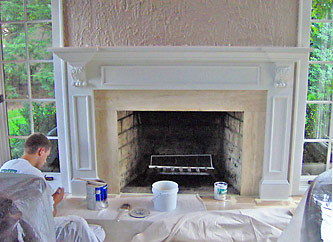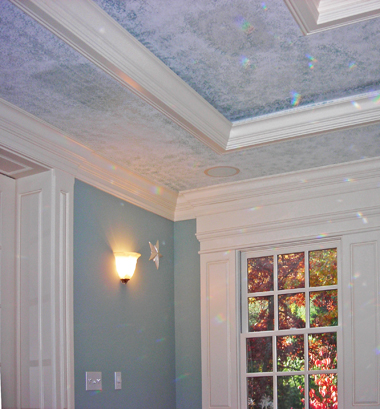
What’s the biggest time investment involved with painting a room? Any professional will tell you that painting preparation takes the most time. And if you are going to be completely satisfied with the outcome, meticulous preparation is a must. In fact, one of the best reasons to hire a professional painter is to avoid the hassle involved with getting the job done right. Other challenges involved with painting a room include knowing what colors to choose, what type of paint to use, the right brushes for the job, and more – but the entire project begins with proper preparation. To help you get started on the right foot, see the following information about the best way to prep for painting a room.
Prepare the Room
The first steps involved in preparing a room for painting include removing items:
• Remove all wall hangings and all of the furniture that you can. Items that remain should be pushed together in the center of the room. Cover the furniture with a drop cloth.
• First turn off the power and then remove cover plates from all outlets, switches, electrical fixtures, and light fixtures. To prevent paint from sticking to them, place masking tape over the switch handles and outlets. Use a plastic bag to cover any fixtures which can’t be removed.
• Remove air conditioning and heating vent covers.
• Remove all nails and hooks from the walls.
• Remove or tape to cover doorknobs and door hardware.

Additional steps:
• Tape around doors, moldings, and windows with removable masking tape.
• Protect the entire floor with drop cloths.
• Use a plastic bag to cover the smoke detector.
• Before sanding and painting, turn off the air conditioning or heating.
• If the room is carpeted, (in addition to the drop cloth), cover the carpet along the edge of the baseboard with a wide strip of tape; use a putty knife to secure the taping on the carpet to the narrow space underneath the baseboard.
• Secure pets so that they stay out of the room being painted.
Prepare the Walls
You will rarely get the best results painting a room by simply digging into the job without first preparing the wall. The following are some of the steps you may need to take to properly prepare the surface to be painted:
• Vacuum the walls and ceiling.
• Wash the walls with a small amount of diluted soapy water. This will remove any build-up on the walls and is an especially important step when painting a bathroom or kitchen. Wipe down the walls with a damp, lint-free cloth and allow the surfaces to dry thoroughly.
• Use sandpaper or a paint scraper to scrape any flaking or loose paint from the walls.
• If there is glossiness to the current paint, remove the sheen prior to painting. This can be accomplished with a light grade of sandpaper.
• Restore the wall to a smooth surface. Fill any nail holes with a high quality spackling compound using a putty knife. Cracks in the wall should be filled with caulking. For seriously damaged wood surfaces, epoxy filler may be needed.
• If the walls or ceiling has any discoloration, you may want to use a stain blocker prior to painting; otherwise, the stain could show through the new paint job.
Once you prep for painting and your walls are ready for fresh paint, you are set to proceed. But your next decision is whether or not to apply primer first before the primary paint color. This is just one more detail that requires your judgement call, or another added value when you are depending upon the expertise of a professional painter instead of doing it yourself!
Franklin Painting LLC – Call us Toll Free at 877-646-7774
or at our main office number 860-678-7701
2 Eastview Drive, Farmington, CT 06032
Exterior House Painting in CT towns like farmington, ct 06032 – avon, ct 06001 – simsbury, ct 06070 – west simsbury, ct 06092 – canton, ct 06019 – burlington, ct 06013 – bloomfield, ct 06002 – unionville, ct 06085 – weatogue, ct 06089 – suffield, ct 06078 – windsor, ct 06095 – granby, ct 06035 – collinsville, ct 06022 – west hartford, ct 06110 – 06117 – 06119 – 06127 – 06133 – 06137 / bristol, ct 06010 – new britain, ct – 06050 – 06051 – 06052 – 06053 / newington, ct 06111 – wethersfield, ct 06109 – cromwell, ct 06416 – rocky hill, ct 06067- berlin, ct 06037 – kensington, ct 06037 – portland, ct 06480 – middletown, ct 06547 – meriden, ct 06450 – middlefield, ct 06455 – east hampton, ct 06424 – chesire, ct 06410 – southington, ct 06489 – glastonbury, ct 06033 – south glastonbury, ct 06073- south windsor, ct 06074 – elllington, ct – east windsor, ct 06088 – hebron, ct 06248 – marlborough, ct 06447 – manchester, ct 06040 – 06042 – 06045 – bolton, ct 06043 – colchester, ct 06415 – tolland, ct 06084 and more!

Frank Campanelli, the esteemed founder of Franklin Painting LLC, has been leading the company since 1986. He takes immense pride in the stellar reputation his dedicated team has built by consistently delivering top-notch service to each customer.




